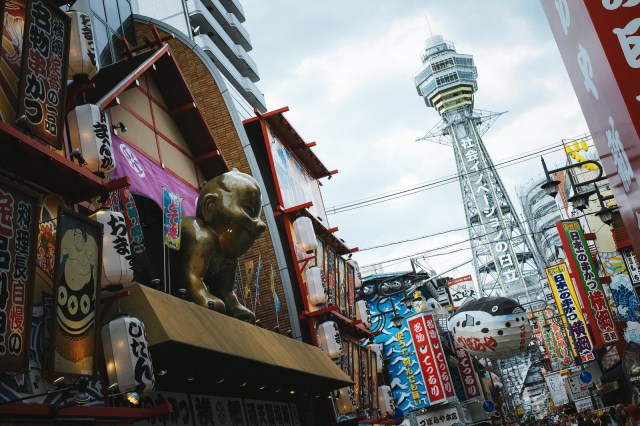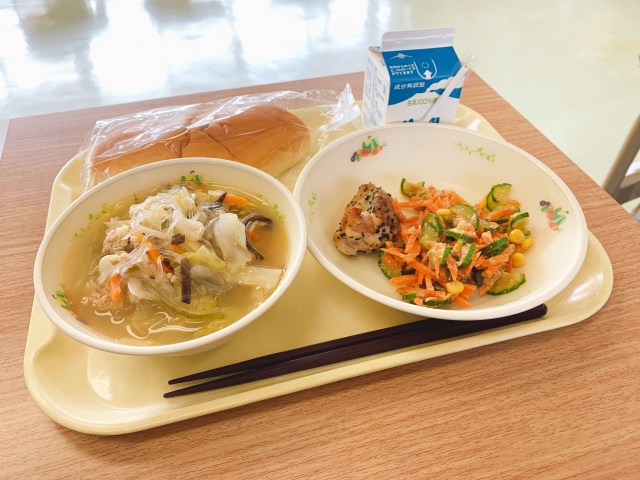
Logistical mishaps and contradicting guidelines hinder what could be one of the best ways to lower COVID-19 community transmission.
While Japan has kept the number of imported cases of COVID-19 low with restricted borders, the nation is struggling to contain the spread of COVID-19 domestically as larger cities such as Tokyo grapple with a fourth wave of infections. One of the most hard-hit areas in particular has been Osaka, and given the circumstances, closing schools and transitioning to remote learning is one of the most logical things to do. However, attempts by Osaka City’s board of education have been bombarded with logistical hiccups and confusing guidelines which have raised anger among educators.
▼ The skyline of Osaka’s central hub, pre-COVID-19 and pre-pufferfish-exodus.
Osaka is one of the few cities in Japan attempting a transition to remote learning — which is not only important in reducing the local transmission of COVID-19, but an opportunity to set a leading example within a country where constitutional limits forbid nationwide mandates even in a public health crisis — and some schools have been going back and forth between staying closed or resuming lessons as usual.
Unfortunately, the city’s efforts have been bogged down in multiple different ways, and we’ve found three main issues hindering Osaka’s transition to remote learning for elementary as well as junior high school students.
▼ A visual representation of how we imagine Osaka educators to be feeling right now.
The first issue is ensuring student accessibility to remote learning technology. While MEXT (Ministry of Education, Culture, Sports, Science and Technology) jumpstarted a program called the GIGA School Initiative to provide Internet-connecting devices, particularly to elementary and junior high school students after the pandemic’s onset, according to a recent study performed by the initiative, the ratio of students to Internet-connecting devices, whether smartphone, tablet or computer, is at one device per five students on both a national level and in Osaka Prefecture.
▼ Of the devices delivered, it seems tablets are the most common, though this is no surprise given their ease of use and similarity to smartphone software.
Of course, simply ensuring everyone has the tech doesn’t mean everything’s ready to go, and this leads to a second hurdle: adapting to remote learning, which has been a struggle for many. From familiarizing themselves with remote-teaching methods, easing students into taking classes online, and the troubleshooting of tech issues, teachers in Osaka have signaled that they are falling behind with little time to spare for catching up. It doesn’t help that Osaka City’s board of education had set a rather strict deadline, announcing its new remote-learning policy for elementary and middle schools on April 22 and calling for schools in the area to begin remote learning on April 25, which only allowed three days for instructors, school staff, students, and parents to prepare for an education style which is still extremely rare in Japan.
▼ No pressure for the local IT staff working at schools!
But what has truly raised the ire of Osaka City educators isn’t the logistical slowdowns nor the lack of time given for the transition, but a guideline directing students to return to school for lunch during the remote-learning period. So far, the guidelines have received considerable blowback from both school staff and Japanese netizens alike:
“Aren’t… aren’t we getting our priorities completely backward if we make the students learn online but still go to school for lunch?”
“And all this time we keep getting told not to dine together.”
“They should consider the school staff more and also not put kids at risk…”
“But isn’t eating when infectious droplets spread the most?”
“If they want to really do this, then they better figure out a way to protect the staff preparing school lunches.”
▼ A picture of the typical lunch provided by schools.
Granted, schools offering lunch is a vital part of the community safety net, especially for students affected by food poverty. However, forcing every student, regardless of their situation, to return to school for lunch seems to contradict the purpose of keeping schools closed in the first place, and with cases rising, the anger expressed by teachers and locals is understandable. At the end of the day, it may seem like common sense to shut down schools, but then again, some pretty wild takes have been given in the past year by local leaders regarding preventative measures against COVID-19.
▼ It takes a village for even one small part of a school’s daily operations, and students as well as staff deserve a safe working environment.
During a time period riddled with anxiety and uncertainty, the last thing teachers, who are viewed but not necessarily treated as one of the backbones of human society, and students need is a higher risk of contracting COVID-19. And while it’s too early to determine how Osaka City’s transition to remote learning will pan out, we sincerely hope policy adjustments are made as it’s believed that vaccine rollout won’t reach the general public until mid-July at the earliest.
Related: MEXT Giga School Initiative
Source: Yahoo News! via Hachima Kiko, Sankei News
Top image: Pakutaso
Insert images: Pakutaso (1, 2, 3, 4), Photo AC, Wikimedia/Osamu Iwasaki
● Want to hear about SoraNews24’s latest articles as soon as they’re published? Follow us on Facebook and Twitter!






 1 in 20 Japanese junior high school students regularly missing school, government study finds
1 in 20 Japanese junior high school students regularly missing school, government study finds Kyoto families angered by new policy forcing high school students to buy tablets at own expense
Kyoto families angered by new policy forcing high school students to buy tablets at own expense Japanese students start online movement to keep schools closed amid coronavirus fear
Japanese students start online movement to keep schools closed amid coronavirus fear Japanese students skip school to protest their re-opening amid growing number of COVID-19 cases
Japanese students skip school to protest their re-opening amid growing number of COVID-19 cases Middle School Students Forced to Drink Acid as Punishment
Middle School Students Forced to Drink Acid as Punishment Brand-new all-Harry Potter theme park could be opening in Tokyo
Brand-new all-Harry Potter theme park could be opening in Tokyo Cup Noodle tries an authentic Jiro-style ramen, but something’s not quite right
Cup Noodle tries an authentic Jiro-style ramen, but something’s not quite right What did Shibuya really look like after the crowds on New Year’s Day?
What did Shibuya really look like after the crowds on New Year’s Day? Hayao Miyazaki says Happy New Year to Studio Ghibli fans with new art for Year of the Horse
Hayao Miyazaki says Happy New Year to Studio Ghibli fans with new art for Year of the Horse One of Tokyo’s best hot spring complexes is closing for good
One of Tokyo’s best hot spring complexes is closing for good Ginza hotel serves up one of the best breakfasts in Tokyo
Ginza hotel serves up one of the best breakfasts in Tokyo You can now visit a recreation of Evangelion’s Tokyo-3 and live there in miniature form in【Pics】
You can now visit a recreation of Evangelion’s Tokyo-3 and live there in miniature form in【Pics】 Starbucks Japan unveils new Sakura Frappuccino for cherry blossom season 2025
Starbucks Japan unveils new Sakura Frappuccino for cherry blossom season 2025 Kansai-exclusive takoyaki Cup Noodle lives up to half of the expectations its name produces
Kansai-exclusive takoyaki Cup Noodle lives up to half of the expectations its name produces Evangelion original anime studio Gainax is now completely dissolved, Eva’s creator mourns ruined friendships
Evangelion original anime studio Gainax is now completely dissolved, Eva’s creator mourns ruined friendships Starbucks Japan ready to get Year of the Horse started with adorable drinkware and plushies【Pics】
Starbucks Japan ready to get Year of the Horse started with adorable drinkware and plushies【Pics】 7 great places to see Mt. Fuji from without having to climb it
7 great places to see Mt. Fuji from without having to climb it Cyberpunk anime meets traditional culture in Ghost in the Shell gold leaf Japanese changing screens
Cyberpunk anime meets traditional culture in Ghost in the Shell gold leaf Japanese changing screens Hello Kitty Choco Egg figures are an adorable trip through three periods of Japanese pop culture【Pics】
Hello Kitty Choco Egg figures are an adorable trip through three periods of Japanese pop culture【Pics】 We found possibly the quietest Japanese-style hotel in Tokyo’s bustling Shinjuku district
We found possibly the quietest Japanese-style hotel in Tokyo’s bustling Shinjuku district 7-Eleven Japan’s ramen-cooking robot whipped us up a bowl of noodles【Taste test】
7-Eleven Japan’s ramen-cooking robot whipped us up a bowl of noodles【Taste test】 Sumo Sanrio! Hello Kitty and pals team up with Japan Sumo Association for new merch【Pics】
Sumo Sanrio! Hello Kitty and pals team up with Japan Sumo Association for new merch【Pics】 Japan’s oldest largetooth sawfish in captivity back on display in Mie Prefecture
Japan’s oldest largetooth sawfish in captivity back on display in Mie Prefecture More Than a Capsule Stay: Why Solo Travelers Choose “global cabin Yokohama Chinatown”
More Than a Capsule Stay: Why Solo Travelers Choose “global cabin Yokohama Chinatown” 7-Eleven Japan starts new temporary luggage storage service in over 300 branches
7-Eleven Japan starts new temporary luggage storage service in over 300 branches Disillusionment at Tsukiji’s tourist-target prices led us to a great ramen restaurant in Tokyo
Disillusionment at Tsukiji’s tourist-target prices led us to a great ramen restaurant in Tokyo Starbucks teams up with 166-year-old Kyoto doll maker for Year of the Horse decorations【Photos】
Starbucks teams up with 166-year-old Kyoto doll maker for Year of the Horse decorations【Photos】 Tokyo considering law requiring more trash cans following litter increase in heavily touristed area
Tokyo considering law requiring more trash cans following litter increase in heavily touristed area Tokyo’s Tsukiji sushi neighborhood asks tour groups to stay away for the rest of the month
Tokyo’s Tsukiji sushi neighborhood asks tour groups to stay away for the rest of the month Tokyo event lets you travel back in time, for free, to celebrate 100 years since Showa era start
Tokyo event lets you travel back in time, for free, to celebrate 100 years since Showa era start Sanrio theme park in Japan announces plans to expand into a Sanrio resort
Sanrio theme park in Japan announces plans to expand into a Sanrio resort Japan may add Japanese language proficiency, lifestyle classes to permanent foreign resident requirements
Japan may add Japanese language proficiency, lifestyle classes to permanent foreign resident requirements Stamina-destroying “Paralysis Noodles” are Tokyo’s newest over-the-top ramen innovation
Stamina-destroying “Paralysis Noodles” are Tokyo’s newest over-the-top ramen innovation Survey asks foreign tourists what bothered them in Japan, more than half gave same answer
Survey asks foreign tourists what bothered them in Japan, more than half gave same answer Japan’s human washing machines will go on sale to general public, demos to be held in Tokyo
Japan’s human washing machines will go on sale to general public, demos to be held in Tokyo Japan’s deadliest food claims more victims, but why do people keep eating it for New Year’s?
Japan’s deadliest food claims more victims, but why do people keep eating it for New Year’s? We deeply regret going into this tunnel on our walk in the mountains of Japan
We deeply regret going into this tunnel on our walk in the mountains of Japan Studio Ghibli releases Kodama forest spirits from Princess Mononoke to light up your home
Studio Ghibli releases Kodama forest spirits from Princess Mononoke to light up your home Major Japanese hotel chain says reservations via overseas booking sites may not be valid
Major Japanese hotel chain says reservations via overseas booking sites may not be valid Put sesame oil in your coffee? Japanese maker says it’s the best way to start your day【Taste test】
Put sesame oil in your coffee? Japanese maker says it’s the best way to start your day【Taste test】 No more using real katana for tourism activities, Japan’s National Police Agency says
No more using real katana for tourism activities, Japan’s National Police Agency says Starbucks Japan reveals new sakura drinkware collection, inspired by evening cherry blossoms
Starbucks Japan reveals new sakura drinkware collection, inspired by evening cherry blossoms Updated cherry blossom forecast shows extra-long sakura season for Japan this year
Updated cherry blossom forecast shows extra-long sakura season for Japan this year Japanese junior high school student pranks teacher by lacing school lunch with laxative
Japanese junior high school student pranks teacher by lacing school lunch with laxative Japanese elementary school teacher gets drunk, visits student’s house and beats him with stick
Japanese elementary school teacher gets drunk, visits student’s house and beats him with stick Naturally brown-haired Osaka student sues government for forcing her to dye her hair black
Naturally brown-haired Osaka student sues government for forcing her to dye her hair black Tokyo middle school leaflet asks students to write down, turn in their social media passwords
Tokyo middle school leaflet asks students to write down, turn in their social media passwords Junior high school in Japan introduces trial afternoon nap time for students
Junior high school in Japan introduces trial afternoon nap time for students Petition started to stop forcing students to cheer for their high school baseball teams
Petition started to stop forcing students to cheer for their high school baseball teams Elementary and junior high students speak out on Japan’s strangest school rules
Elementary and junior high students speak out on Japan’s strangest school rules Public high school in Japan’s Gifu Prefecture will no longer take student absences into account for entrance applications
Public high school in Japan’s Gifu Prefecture will no longer take student absences into account for entrance applications Japanese Komeito party suggests 20,000 yen (US$189) grant for graduating high school students
Japanese Komeito party suggests 20,000 yen (US$189) grant for graduating high school students Japanese high school teacher in hot water after forcibly giving male student a buzz cut
Japanese high school teacher in hot water after forcibly giving male student a buzz cut High school students rapidly losing interest in sumo teams because too “painful,” “scary,” and “naked”
High school students rapidly losing interest in sumo teams because too “painful,” “scary,” and “naked” Students go nearly a year without textbooks after teacher forgets to hand them out
Students go nearly a year without textbooks after teacher forgets to hand them out Tokyo public schools will stop forcing students with non-black hair to dye it, official promises
Tokyo public schools will stop forcing students with non-black hair to dye it, official promises Japanese elementary teacher busted for hiding students’ shoes, writing “die” on their belongings
Japanese elementary teacher busted for hiding students’ shoes, writing “die” on their belongings Japanese PM asks schools around Japan to close as coronavirus cases rise
Japanese PM asks schools around Japan to close as coronavirus cases rise
Leave a Reply